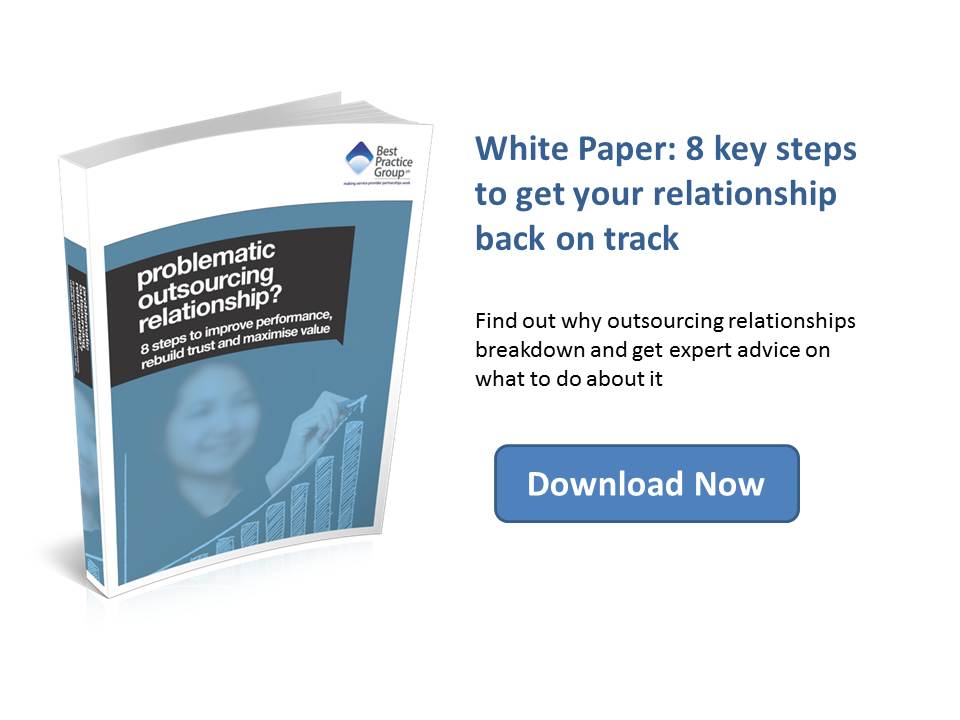 While the theory behind outcome-based pricing models is nothing new, the penchant for establishing relationships specifically based on driving true added value is certainly growing in popularity with both vendors and clients.
While the theory behind outcome-based pricing models is nothing new, the penchant for establishing relationships specifically based on driving true added value is certainly growing in popularity with both vendors and clients.
The reasons for this are simple. With suppliers utilising their own resources and best practices, they have an opportunity to (a) bring some much needed fresh thinking to client service delivery innovation and options, (b) reduce the on-going costs of service delivery to their client base and (c) achieve greater margins which incentivises them to innovate all the more to drive much better outcomes (subject to how they are measured/managed).
For the client’s part, it’s a win-win. If correctly implemented, they receive higher-quality results that focus specifically on what they are looking to achieve from the relationship and a strong partnership which allows them to focus on their core strategic activities instead of the mechanics of optimising service delivery.
Additionally, the implementation of transparency, clarity, quantified performance measures and streamlined governance are also key to the success of any outcome-based pricing model. These are all features that we extol the virtues of on a regular basis in our articles.
Our experience of being asked to come in after the event, in hundreds of strategic service delivery relationships to help realign the outcomes for all parties, have provided us with evidence of five important steps to implementing an outcome-based pricing model (on the basis that your own particular relationship[s] are suited to this type of model):
1 – Are you ready for outcome-based pricing?
Not every organisation, or every strategic relationship that an organisation undertakes, is suited to this type of pricing model. If you do not have the expertise, the time or the resources to quantify the outcomes and benefits you wish to achieve in enough detail, then you may need to remain with input and transactional based models for now. Clarity is paramount in outcome-based pricing so it is never advisable to launch into such a model without the proper research and resources. Over time you may be able to gather enough evidence on what is working towards desired outcomes and what isn’t. At that point you can use this evidence to develop an outcome based matrix that accurately quantifies the benefits that you’ll expect from the service being delivered. By quantify we mean identifying in which areas, by how much, and by when these improvements could be made. At that point, you can then consider an outcome-based pricing model that shares the risks and rewards on a fair and equitable basis.
2 – Can you quantify the gap between what you have now and what you are trying to achieve?
Our experience tells us that outcome-based pricing is usually best led by quantified research. The most effective starting point of a successful relationship is often a clearly quantified baseline of where you are now against those future benefits and outcomes you are trying to achieve. Ensuring you have specific clarity before you enter into any outcome-based pricing model is fundamental. The types of questions you need to be asking yourself are:
- What your existing costs are?
- In which areas are these costs occurring?
- Can you quantify the size of your teams, payroll, overheads on all of them?
- Are existing service levels in each of those areas a baseline starting point?
It’s important to go through the same process and method for the outcomes you are hoping to achieve as a result of the relationship being successful. This process will help you identify a clear quantified gap that everyone involved will be able to see and understand, between where you are now and where want to be.
It is important to determine what proportion of that benefit, in financial terms, you would be happy to incentivise your provider with in order to achieve the business outcomes that you’ve quantified. As a guide, figures between 10% and 25% are not uncommon, depending on the up-front financial investment the provider has to make to innovate and change the service and the risk involved in the service delivery process. Risks can be minimised and opportunities maximised through milestone triggered bonuses to further incentivise quality standards and innovation.
3 – Give your provider the information and the time to sense-check your expectations
‘Real’ collaborative relationships achieve better results. It is essential to appreciate that your provider needs clarity from you. You must provide them with all they reasonably ask for to be able to provide you with the right advice and that you do so in a timely fashion. Sit down with your provider to explain clearly what you need and wish to achieve. They will require adequate time to do their own due diligence on both the baselines you’ve created regarding your existing costs and outcomes/objectives, so they can validate that they perceive them to be as correct and accurate as you do, and to validate the expected benefits you’ve articulated to determine whether they are truly realisable within the time frames given. An aligned terms of reference needs to be supplied to the provider for the due diligence exercise to make sure they report on what outcomes can be realised, those that cannot, and what the impact on the overall business outcomes you are trying to achieve is of those outcomes that cannot be realised. A specialist provider is bound by a ‘duty to warn’ you of any material expectations you have, should they perceive them to be unrealistic or there are skill gaps in their ability to service your needs. However, you must bear responsibility for supplying them with the information they ask for in a detailed and accurate manner and in good time for them to run their own assessments.
4 – Develop a detailed plan of action
The devil is in the detail when it comes to this type of outcome based pricing model. Your implementation and milestone plan must be clear and detailed, identifying the benefits and outcomes to be achieved, how they will be measured and performance managed, and when payments to the vendor will actually be made. As a client, you need to supply the resources and skills that you said you’d supply when you said you would do so, or the provider cannot achieve the outcomes it is trying to achieve for you. This is a potential practical issue, but it could end up being a legal one as well. In the event that the service delivery goes awry and you intend to pursue legal recourse, then your own actions of whether you have assisted or hindered the vendor (albeit inadvertently) will be taken into account. And, if it is found that what you’ve done, or to be more precise, what you’ve not done, has contributed to the situation you found yourself in, then this will severely weaken your legal case. But legalities aside, you just want the relationship to work, drive the right behaviours between you and so that both you and your vendor have business outcomes that meet your mutual expectations on a fair and equitable basis.
5 – Structure sufficiently holistic contractual terms
We don’t want to talk about ‘Courts’ as such. However, ultimately, arguing over whether an outcome based payment is due because of misunderstandings over a lack of quantification in expectations or to some poorly worded contractual obligations, won’t help either of you. While a court will consider each sides’ behaviours over and above the written agreement you have between you, in addition to pre-contract assertions, emails and the environment that was created, it is still important to ensure that your written contract contains as much of the detail that you would wish a provider to rely upon to achieve the outcomes you’re expecting from them.
Written contracts should contain (and be updated on at least a 6 monthly basis):
- The quantified outcomes and benefits you’d expect from the provider.
- The terms of reference for the due diligence report they need to undertake to validate your expectations.
- The due diligence report itself – what they can and cannot do for you.
- An implementation plan that’s been agreed to realise these benefits and outcomes against the pricing model.
- The sources and skills (not named individuals) that the provider and you as the client say you’ll put in and that are aligned to the outcomes of the service delivery.
Outcome-based pricing – Conclusion
The above steps provide a fair and equitable foundation upon which you as the client can ensure you have the best opportunity of receiving the most appropriate advice from your provider to (a) achieve your business outcomes and (b) the vendor gets its fair and equitable share of ‘over-delivering’ for you.
In turn, if service delivery does not align as expected, despite your best efforts of genuinely supporting your vendor to do its bit, then this process will also allow you to hold the vendor accountable to make sure that it realigns its service delivery and it delivers what it says it’s going to deliver, when it says it’s going to deliver it.
But also as a client, you will be accountable to make sure you will do what you say you are going to do when you say you are going to do it, in order that you do not impede the vendor from delivering the outcomes you expect from them (co-dependency).
These five steps are the key starting principles to implement an effective outcome-based pricing model. From this strong foundation, great things can flourish. Direction, guidance, regular monitoring, mutual responsibility and quantified expectations to benchmark progress and success against are all cornerstones of an efficient collaborative working relationship grounded in reality.
Photo credit: Shutterstock


